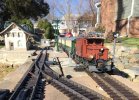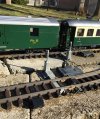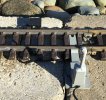Airbuspilot
Registered
I am helping a friend with his extensive G scale garden layout and we are looking at the possibility of automating a section. The idea will be to use a circular area with a diagonal for direction change. We are using ZIMO MX 10 as the base station and iTrain for the automation. On my own N scale layout I am using Digikeijs DR 4108 as my current feedback, this is too small for G scale and I would be interested in opinions for a suitable equivalent for G Scale.
Using current feedback is not an issue for the circular portion of the track as it will have a common rail and insulated feedback block rails. However I am not sure how to deal with the diagonal. This section has a reverse loop sensor which is powered, but not necessarily drawing current. I am not sure if a current sensor will work on this section or if it might interfear with the reverse loop electronics? If anyone has dealt with this situation i would appreciate your views.
If current sensing is not possible can you suggest an alternative?
This diagram is only an illustration in reality there will be two diagonals.
Robin
Using current feedback is not an issue for the circular portion of the track as it will have a common rail and insulated feedback block rails. However I am not sure how to deal with the diagonal. This section has a reverse loop sensor which is powered, but not necessarily drawing current. I am not sure if a current sensor will work on this section or if it might interfear with the reverse loop electronics? If anyone has dealt with this situation i would appreciate your views.
If current sensing is not possible can you suggest an alternative?
This diagram is only an illustration in reality there will be two diagonals.
Robin





